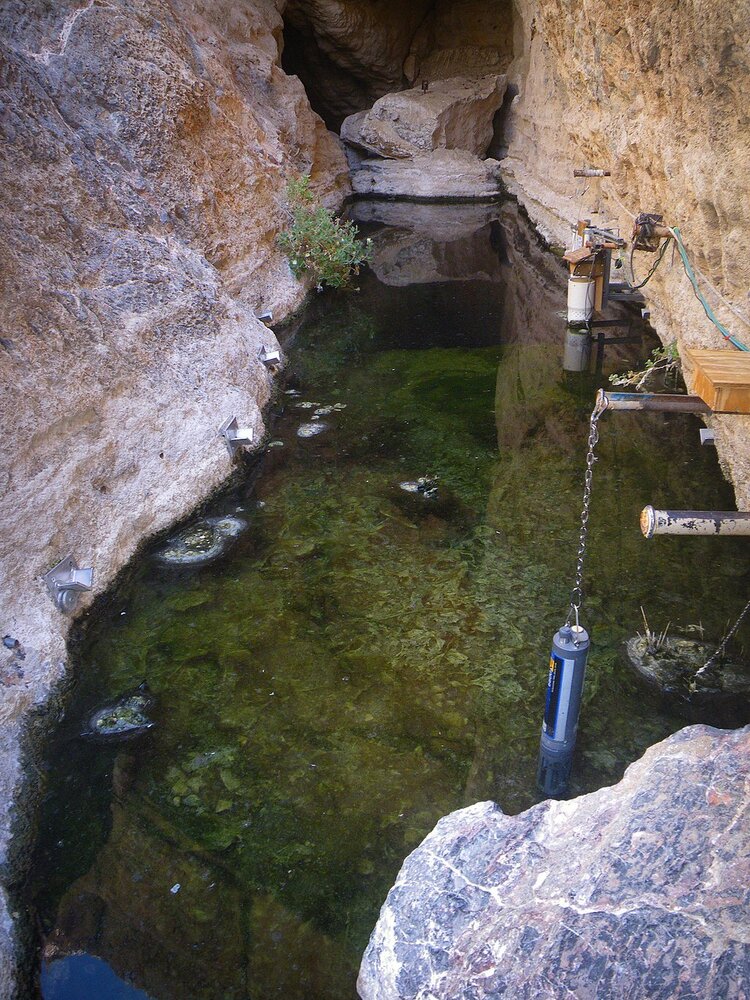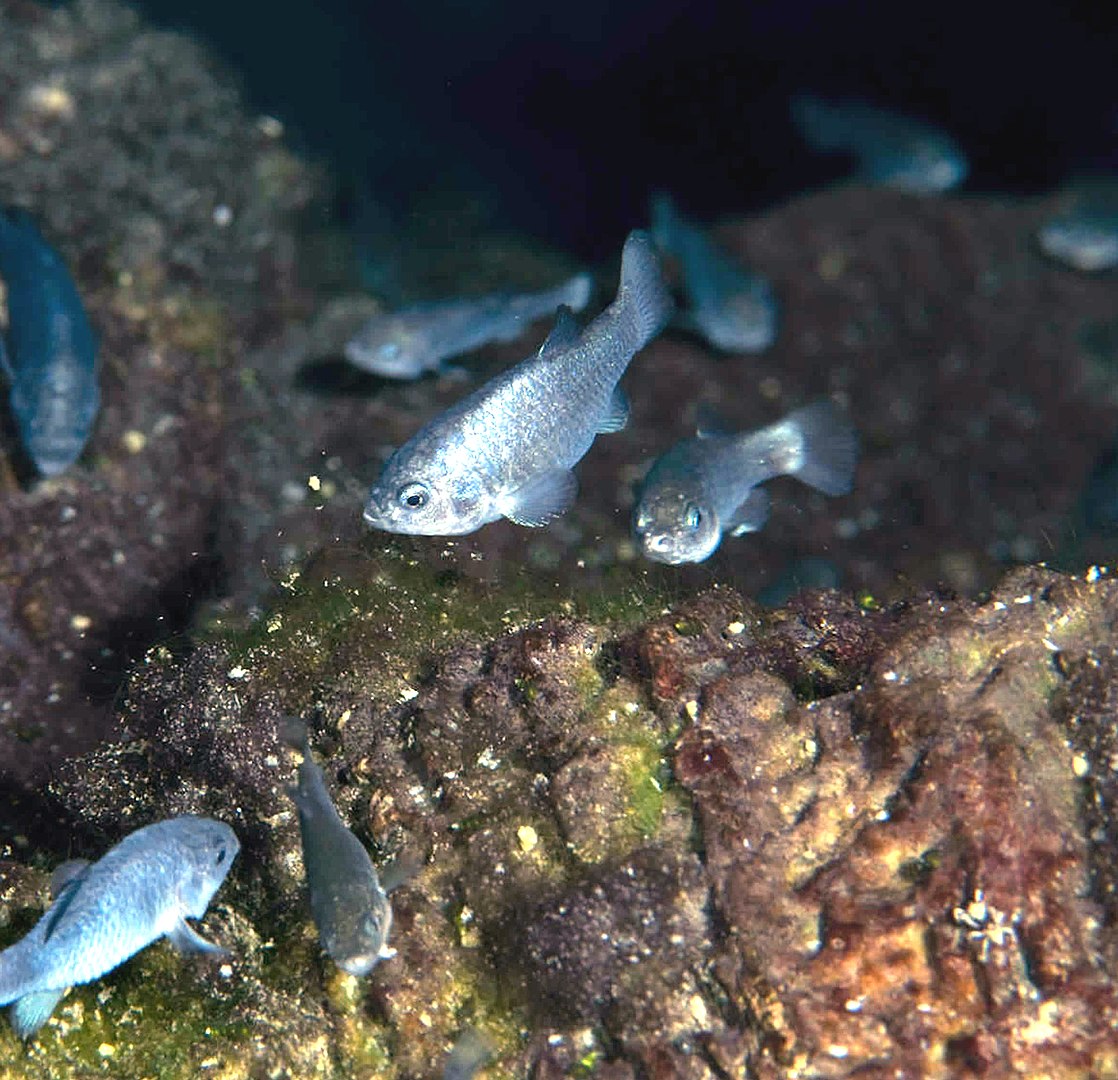by Liz Kimbrough on Mongabay 30 May 2024
- The critically endangered Devils Hole pupfish population has reached a 25-year high of 191 fish, offering hope for the species that lives in the smallest known habitat of any vertebrate.
- Above water and SCUBA surveys conducted by scientists twice a year carefully monitor the pupfish population in Death Valley, Nevada, which has fluctuated dangerously in the past, dropping as low as 35 individuals in 2013.
- A landmark 1976 Supreme Court decision, informed by environmental science, protected the pupfish by limiting groundwater pumping that threatened its habitat, setting a precedent for science-based conservation policy.
- Despite recent success, the pupfish remains threatened by climate change impacts on the delicate desert ecosystem, as well as growing human demand for water resources in the region.
In a glimmer of hope for one of the world’s rarest fish, scientists have counted 191 Devils Hole pupfish this spring in their tiny desert habitat. This number marks the highest spring count for the critically endangered species in more than two decades.
The Devils Hole pupfish ( Cyprinodon diabolis) is found only in the upper reaches of a single deep limestone cave in the Mojave Desert in the western U.S. state of Nevada. The entire species lives on a shallow rock shelf measuring 3.3 by 4.8 meters (11 by 16 feet), making this the smallest known range of any vertebrate species on the planet.
Twice a year, biologists from the National Park Service, U.S. Fish and Wildlife Service, and Nevada Department of Wildlife peer from scaffolding above the pond and then enter the water with scuba gear to count pupfish in Devils Hole. They methodically comb the entire habitat, from the sunny shallows to depths of more than 30 m (100 ft), looking for the iridescent blue desert dwellers.
“It was really encouraging to see such a large number of young fish during these spring dives,” said Brandon Senger, supervising fisheries biologist for the Nevada Department of Wildlife, who has been conducting scuba counts at Devils Hole since 2014. “Conditions within Devils Hole looked healthy, so we have hopes of high recruitment over the coming months that will lead to a large population in the fall.”

fish
The Devils Hole pupfish is a marvel of adaptation. It has evolved to withstand the harsh conditions of its desert habitat, including water temperatures that can reach 34° Celsius (93° Fahrenheit) and extremely low oxygen levels. The pupfish has a unique metabolic rate that allows it to survive on minimal food resources, primarily feeding on the algae that grow on the shallow rock shelf. Its small size and rapid life cycle of just 12 to 14 months enable the species to maintain a population in the confines of its tiny habitat.
Despite these remarkable adaptations, the pupfish has faced numerous threats over the years. The history of conservation efforts for the Devils Hole pupfish is a case study in the interplay between environmental science and policy. In 1952, then-president Harry Truman added Devils Hole to Death Valley National Monument. In the late 1960s, the pupfish faced its first major threat when groundwater pumping by local farms began to lower the water level in Devils Hole, exposing the critical shallow shelf.
In 1976, the Supreme Court ruled that the federal government had a right to protect the water level in Devils Hole, limiting groundwater pumping in the region. The ruling was based on the scientific understanding that the pupfish depended on a stable water level to survive. This case set a precedent for using environmental science to guide policy and legal decisions.
Despite this victory, the pupfish population continued to fluctuate dangerously. In 2013, scientists counted just 35 pupfish, leading to fears that the species could wink out of existence. Careful conservation efforts, including supplemental feedings with special food pellets, have helped bolster their numbers.
A natural disaster may have also contributed to the recent population rebound. Last summer, the remnants of Hurricane Hilary inundated Death Valley National Park, damaging roads and infrastructure. But the silt and clay swept into Devil’s Hole by the floodwaters benefited the pupfish by providing nutrients for algae growth.
“It’s exciting to see an increasing trend, especially in this highly variable population,” said Michael Schwemm, senior fish biologist for the U.S. Fish and Wildlife Service.
However, the future of the Devils Hole pupfish remains uncertain. Climate change is disrupting the delicate desert ecosystem with increasing temperatures and erratic weather events. In recent years, Death Valley has experienced record-breaking heat waves and intense flash flooding.
“As the climate changes, as world temperatures get hotter, Death Valley will get hotter,” Nichole Andler, chief of interpretation for Death Valley National Park, said in an interview. She pointed out that seven of the park’s hottest summers have occurred in the last decade.
Increasing urbanization, recreational use and industrial activities like mining also place greater demands on the aquifer that feeds Devils Hole. Even minor changes in water level can expose critical habitat, imperiling the fish.
Further complicating conservation efforts, the Devil’s Hole pupfish population is highly inbred due to its isolation and small population size, which has led to reduced genetic diversity. Low genetic variation can make the species more vulnerable to disease, environmental changes and developmental abnormalities, posing significant challenges for the pupfish’s long-term survival and recovery.
To safeguard the species, captive-breeding programs are underway to establish a backup population in case of a catastrophic event in the wild. But ultimately, the fate of the Devils Hole pupfish is tied to the health of its unique desert habitat.
“The pupfish is an indicator of the health of the larger ecosystem,” Kevin Wilson, an ecologist with the National Park Service, said in an interview. “By protecting this tiny fish, we’re protecting the aquifer and the entire web of life that depends on it.”
Banner image A group of critically endangered Devils Hole pupfish(Cyprinodon diabolis) photographed in the Devil’s Hole, Nevada. Photo courtesy of Olin Feuerbacher/ USFWS (CC BY 2.0)
Liz Kimbrough is a staff writer for Mongabay and holds a Ph.D. in ecology and evolutionary biology from Tulane University, where she studied the microbiomes of trees.
Citation:
Langhammer, P. F., Bull, J. W., Bicknell, J. E., Oakley, J. L., Brown, M. H., Bruford, M. W., … & Brooks, T. M. (2024). The positive impact of conservation action. Science, 384(6694), 453-458. doi: 10.1126/science.adj6598
